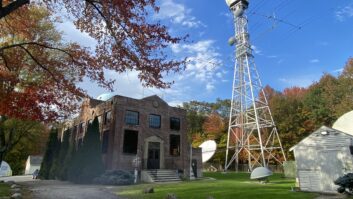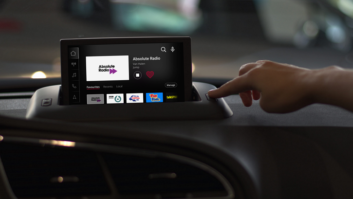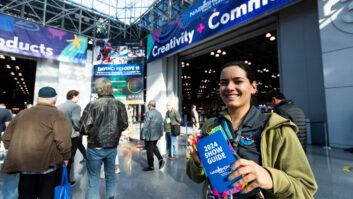It has been an engineer’s bugaboo since the dawn of HD Radio more than a decade ago.
In theory, when a digital HD signal drops below a threshold at which stable reception is no longer possible, a seamless transition to analog should take place. The reverse should occur when a usable HD signal returns.

In practice, the listener’s experience can be more like hitting a pothole in the road. A noticeable switch between digital and analog takes place. To make matters worse, this transition can occur repeatedly as one travels through areas where digital signal strength is marginal.
What’s happening is that the time and level alignment between the FM and HD signals are not in sync. This problem was recognized early on but an entirely satisfactory solution has been difficult to come by.
Over time, the industry’s brain trust focused its energies on the digital delay quandary. Articles were written for trade magazines, papers were delivered at the NAB Show, documents were circulated within radio groups.
Publication of the NRSC-G203 IBOC Time and Level Alignment Guideline by the National Radio Systems Committee in September of 2017 is another step in dealing with these issues. It represents the first time collective wisdom about the issue has been gathered in one place.
The document discusses the causes of time and level alignment drift and how stations can implement automated methods to keep alignment within a specified tolerance. Though many scenarios can cause drift, it reports, the biggest culprit seems to be separation of the Exporter and the Exciter engine components over a wide area network. The guideline discusses implementation of various hardware and software configurations to address timing instabilities. It concludes that ultimately, “the most effective solution to insure good time and level alignment is automated, continuous, real-time monitoring and adjustment of this alignment so as to reduce or eliminate objectionable blending artifacts.”
MONTHS OF WORK
The work is published jointly by the Consumer Technology Association and the National Association of Broadcasters, co-sponsors of the National Radio Systems Committee.
Audible blending artifacts are the top complaint from automakers and consumers regarding HD Radio; and most of the problems can be traced to broadcast stations, where manual management of time and level alignment leads to drift over time.
So the recommendations were developed by a working group of the NAB Radio Technology Committee, whose members are radio engineers and other tech experts. Engineers involved work for companies including Beasley Broadcast Group, Cox Media Group, CBS Radio, Emmis Communications, Hubbard Media, iHeartMedia and NAB. Those were then submitted to the NRSC with a request that it incorporate the information into an NRSC Guideline.
We spoke with industry experts about the importance of this issue, how stations can put these guidelines to use and how we got to where we are with time/level alignment.
Alan Jurison — a senior operations engineer for iHeartMedia’s Engineering and Systems Integration Group and chair of the NRSC RDS Usage Working Group — was a major contributor to the NRSC-G203 document.
He summarized problems that have unfolded over the years with HD timing: “First off, NRSC-5 specifies a timing standard of +/- 3 samples. That was set up in 2005, at the beginning of HD Radio. But it wasn’t made clear exactly what the standard meant, or why it was important.
“Another factor was that 10 years ago, HD Radio penetration in cars was miniscule, so the problem wasn’t really noticed that much,” he said. “Also, we’ve learned a lot about the technology since it was introduced. We used to say separate audio processors for FM and HD were the way to go. Now, we understand that that having two processors actually causes a lot of the blending problems, and the best thing is to have both signals processed in one box.”
Another issue is the standard itself. “NRSC standards compliance is mostly voluntary; the FCC isn’t going to fine you for non-compliance with the time alignment specifications in NRSC-5. That being said, good engineering practice suggests that compliance is important, both for the success of your station and the industry as a whole.”
Today, Jurison said, getting the timing right is more important because the number of cars equipped with HD Radio has increased dramatically.
“We’re now seeing the market penetration of HD-equipped cars at 46 percent of new vehicles sold per year. When these radios abruptly blend from HD to FM and back, listeners usually blame the radio and take the car back to the dealer. But these problems have been created by broadcasters, and we need to fix them.”

Rick Greenhut, director of broadcast business development at Xperi Corp., parent of HD Radio, said that from a financial perspective the decision for first-timers to switch to HD is far less daunting.
“When HD started in 2005, first-generation equipment cost around $45,000, and the license was $25,000. A lot of engineering expertise was also required,” he said.
“Today, fourth-generation HD equipment costs less than $10,000, licensing fees are a lot less, and installation is largely a plug-and-play operation. In most markets, there are opportunities to lease out your HD3 and HD4 signals, so the payback time is greatly reduced. We expect the costs to continue to drop in the future.”
Another driving force is the connected car, where AM/FM signals are the only analog ones left in the entertainment system, and an HD digital signal is really required for a station to be competitive, Greenhut said.
COMPLEX TOPIC
After opening by explaining important terms and providing background including examples of the problem, the document lists examples of typical HD Radio transmission topologies. These are summarized in helpful table form (Fig. A shown) and detailed in individual block diagrams (Fig. B). The subject is complex and there is no way to simplify it to a one-size-fits-all solution. The requirements of various stations make for a variety of transmission topologies, some of which work better than others in maintaining alignment. To the extent that an engineer can configure equipment to match one of the recommended schemes, improvements can be made.

General guidelines and best practices then are discussed in Section 5. For time, level and phase alignment it says a user should:
● Ensure HD Radio subsystems are running the latest software versions as recommended by the manufacturer.
● Make sure GPS connections are properly installed and operational.
● Co-locate the Exporter physically at the same site as the Exgine/Exciter (in most cases this will be the transmitter site).
● Consider co-locating the Importer with the Exporter and Exgine/Exciter if additional program link channels and LAN extension bandwidth are available.
● Use an integrated, single-box main-channel analog and digital audio channel processor for setting delay and processing for digital and analog audio signals.
Suggestions for manual hybrid FM HD Radio time alignment include:
● After rebooting or reconfiguring HD Radio transmission components, wait before adjusting the time delay. This is important in any configuration that uses Exporter-to-Exciter (E2X) clocking, i.e., when the Exporter is not co-located with the exciter. Most systems take several minutes to several hours to establish a stable delay.
● If available, use a precision diversity delay monitor that can show continuous measurements to detect any drifting before making manual corrections.
● When using an older monitor that provides single-point-in-time measurements, make several measurements over time to ensure the setup is stable before making a manual adjustment.
A detailed table provides current software versions for HD Radio transmission equipment from various manufacturers.

Then in Section 6 the authors turn to methods for automated time and level alignment. They note that there are several available methods for automating time, level and phase alignment to maintain long-term stability and that these fall into two categories, “in-line” and “monitor-based.”
Within these categories, choices are available regarding manufacturer and topology; and a subsequent section provides a list of currently available alignment equipment, many of which were evaluated by members of the working group. That table of auto-alignment products is found on pages 37 and 38 of the guideline.
We asked Ben Barber, president/CEO of Inovonics, to describe how an HD alignment processor works:
“It starts with the cross-correlation of 32K samples of the FM and HD signals. That works out to be 3/4 second at 44.1. The firmware in the processor looks for similarities in the audio, and measures the time difference. The best place to put the processor is in the HD1 digital audio feed to the HD exciter or exporter. This gives the processor 8 or 9 seconds to work. The FM is put on a fixed 10-second delay. This gives the processor enough leeway to add or subtract time from the HD signal until the two are perfectly aligned.”

He emphasizes that all adjustments and corrections are done very slowly so they are not audible to listeners. Barber said that the engineer’s maintenance schedule should include having the processor’s log emailed every day for the first week or two after the installation, and checking for glitches. After that, weekly log checks should suffice.
Section 7 of the guidebook contains a table that lists existing monitoring and alignment solutions. Many of these products were evaluated by the members of this Working Group, and software versions of the various components as released by the manufacturers are listed.
An annex provides some of the configuration settings required in the engineering user interfaces of certain specific HD Radio exciter products, for setting up direct clocking from 10 MHz or 1 pps. A second annex republishes Alan Jurison’s full paper from the 2016 NAB Show “HD Radio Diversity Delay Field Observations: The Need for Automatic Alignment.”
The main part of the document concludes with a description of planned activities for the NAB Radio Technology Committee. These include expanding the guidebook to cover AM hybrid HD Radio systems, which can suffer the same alignment problems as their FM brethren. Another project is to assist in the development of next-generation HD equipment, which will be able to maintain time alignment without external devices.
Additional goals for new equipment include lower acquisition and operation costs, which should make the implementation of digital radio more desirable and affordable for the many broadcasters who have yet to participate in this transition.
The guideline is available for download at http://www.nrscstandards.org/.







